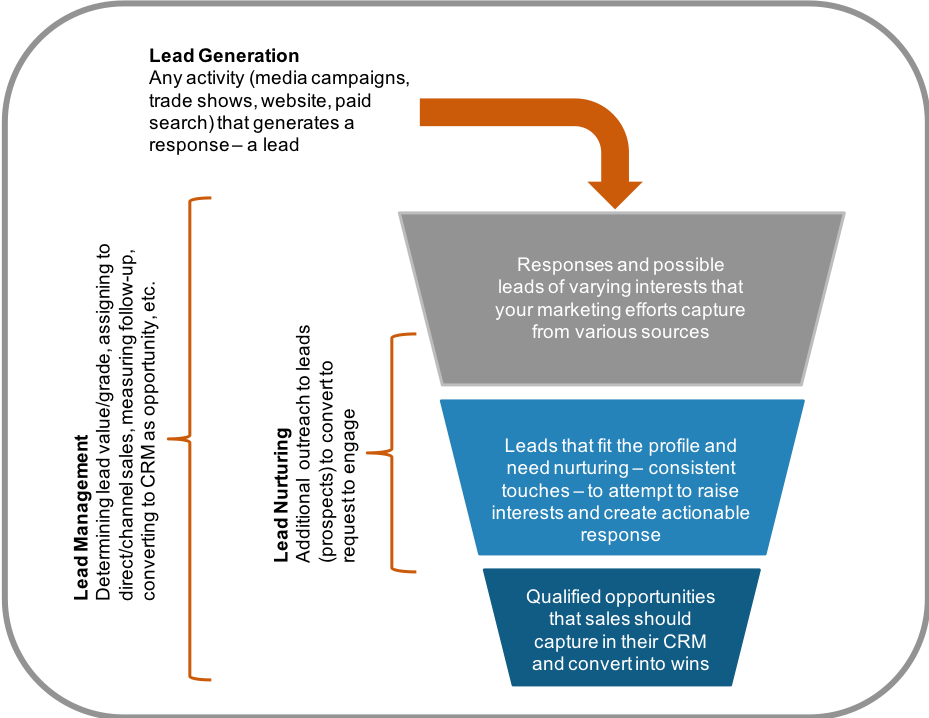B2B Marketing Playbook – Filling the Gaps
With your inventory scores in hand (see Pre-requisite Work), we are ready to locate those gaps in knowledge, skills, or time and start considering what will be a priority in either hiring (as budget allows) or outsourcing in order to accomplish your now-progressing marketing mission. B2B Marketing Playbook
Pre-requisite Work
As I stated in the B2B Marketing Playbook Chapter 1 – Taking Inventory, the logical place to start is to map out the current knowledge and skills you can competently bring to the table yourself, believe you should learn to provide yourself, or will outsource to ensure the success of your marketing efforts. So, if you have not yet completed the inventory forms in the B2B Marketing Playbook Chapter 1, I recommend that you revisit those before completing this chapter.
The inventory likely confirmed one key thing for you: marketing requires knowledge and skills across a vast domain. You scored well in some areas and likely not in other areas. The whole point of a marketing team, which you want to build over time, is to put together a set of employees and outside incremental resources that cover the bases and complement each other. This inventory can help gauge where you are now and create a roadmap over time to accomplish that staffing/outsourcing goal.
Where did you score the highest? Those are areas where you are going to lead and provide key input and skills. Now let’s evaluate the best sources of knowledge and skills to fill the gaps in your lower-scoring areas.
Options for Filling the Gaps
The good news is that you have both internal and external sources of knowledge and skills to fill those gaps we have identified. Below, we will review these sources following along with the inventory form categories.
High-Level Marketing Tasks
Based on the B2B marketers I work with, you were likely selected to lead the B2B marketing efforts for your company for one of two reasons – either you have been working in your company for a while in marketing, sales, or in a product group, or you are a marketing professional hired in from the outside (and may have worked in the same industry or for a compatible-type company). The reason you were chosen for this role will likely determine which strengths you bring to the area of high-level marketing tasks.
If you have been in the company for a while or perhaps have been in the same industry but from another company (in either case, let’s call you an Insider), then you probably scored yourself a bit higher in this high-level marketing inventory category. You know how the industry works and the market opportunity: you have spoken with customers, you have a feel for the buyer’s journey, and you understand the competitive landscape.
If you are from the outside or perhaps have been in marketing internally but new to the company or industry (in either case, let’s call you an Outsider), then you then may have higher scores in areas related to marketing operation but lower scores concerning industry, particular market, and the company/products.
Now that you have identified yourself as an Insider or Outsider, let’s examine some of the resources you should consider and why to augment what you know and what you can deliver.
Internal Resources
Building a strong internal network of advisors, content providers, and advocates (you are going to need those!) is a must whether you are an Insider or an Outsider.
- Advisors– search out the individuals in your company that really “get” the marketing, customers (pains/needs), your unique value to the market, etc. Recruit them as people that you can run ideas past or include in workshops around strategy/messaging/content. Note: management might push you towards certain people – however, my experience is that you find those with the best insight in unusual places (e.g., a customer service rep, salesperson, or a savvy engineer that goes to a lot of conferences), so cast a wide net.
- Content providers – I’m going to save this one for a later discussion on content.
- Advocates – Marketing can be greatly undervalued within companies. Some leadership teams know they need to do it but don’t know much about it; They see the budget and wonder what they get since it’s not always as visible as actual revenue (yes, sales people are the heroes aren’t they?). The answer is to cultivate and educate some key advocates that will work with you to build the end-to-end measurement and appreciation of your impact on the business.
- You must have a least one strong advocate in sales leadership. The two of you have to agree on the accountability of both the marketing and sales teams (what leads or information you will deliver and what they do with those leads or information) and how you measure the results. For example, sales cannot simply reject anything other than leads where the customer is ready to buy. B2B is about relationships and every lead informs sales about where people are in the journey (I will cover more about this in the next chapter – Defining What Success Will Look Like).
- You need an advocate in senior leadership (unless you are senior leadership). Keep them informed, educated, and involved in the process. Set expectations with them on what marketing will deliver to the organization.
- You need a few strong sales people as advocates (outside of sales leadership).
Consider building an actual marketing advisory committee of the people above and hold a quarterly briefing and discussion to keep them engaged.
External Resources
What external resources will prove valuable to you with these High-Level Marketing Tasks?
Well, first of all, there are customers. Yes, customers. There is absolutely no reason you should not make a point to personally do one customer call each week. Find out what your customers love about your company and products. Find out why they buy from you. Find out what you can do better. I call this the “What we do well ….” and “Even better, if … .”
Another strong resource is the media that covers your industry – but wait, I’m not saying you need to sit and read through websites and publications each day. No, indeed! Because of my extensive (23-year) background in media, I am going to suggest something radical. Talk to editors and sales people. Why? Because they have insight into your market, your customers, your company perception in the market, your competitors, your value propositions, and more.
You could also hire (new hire) to get expertise in this area. This is likely the wrong move. Why? Those candidates that have in-depth knowledge to augment this area are likely very senior-level people that, in other companies, are in your position. Might not be a fit. Second, it would be very expensive, and the truth is that through this overall process, you yourself will start to build expertise in this area. If you are going outside to gain help in this area, the next incremental option should serve you better.
The last external source I will name is market/marketing consultants,but I want to be specific here, because when you look at the B2B Marketing “Agency” landscape, very few of them fit into this category. The term “market/marketing consultants” I am using here would refer to either companies or individuals that specialize in research and insights in your specific industry/markets, or companies or individuals that are marketing firms that specialize in your industry/markets. Yes, most marketing consultants will understand “branding” as an exercise and “how” to go about marketing, creative, media, etc., but only a few have enough deep experience in your particular market to have a big impact in this first category. You want to find knowledge/skills from the outside that know MORE about your market than you do!You don’t want to feel like you are working with someone who is waiting to be told what to do – you want them leading in this particular area and bringing big value to your investment in them.
Next, we will discuss priorities to help decide what to consider first as you build your team and capabilities.
Priorities/Actions
Here are my top tips to help you get started in this area:
- You can’t skip the high-level marketing tasks of finding your internal and external resources – this is the foundation for everything you do, and it needs to be done right or your marketing effort will be skewed from day one.
- It costs nothing but time to find your internal sources and talk to customers, and the payoff will be big – so, well, just do it!
- Go ahead and start investing time in cultivating a relationship with a company or individual that fits the outside market/marketing consultant role. Setting your foundation, getting perspective on where to start, and getting clarity around what is and is not possible is important, and this input will be valuable. If there is EVER a time to use this consultant resource, it would be in this area of high-level marketing.
Customer-Facing Messaging
The resources you should use regarding messaging are very straightforward because messaging is not something you do all the time but instead a periodic requirement for overall company/brand messaging and specific initiative messaging.
Never do messaging internally because there is too great a risk of tainting the messaging with you or your team’s own assumptions about your value to customers.
Messaging Resource Roadmap
Here are the key resources you should engage when creating messaging:
- Hire an outside market/marketing consultant to lead/facilitate the messaging process, lead any research, and ultimately write (or work with a writer) to write the actual messaging.
- Engage the key advisors that are related to this particular area of messaging. In every messaging workshop, participants must include key stakeholders such as marketing, sales people that KNOW the area intimately (have been selling and talking to customers a lot), and product engineers (those that create the products and understand the value propositions). Anyone else is just really an observer (and will likely derail the conversation anyway).
- Either use internal or external(through market/marketing consultant firm) research leadership/skills to do the qualitative and quantitative research.
- Qualitative research as you build the initial messaging framework to get input on the customer conversation map.
- Quantitative research to validate your proposed value propositions and messaging.
- Engage a writer that understands the customer perspective in the industry. It might be you if you are a good writer, another internal person, or most likely the market/marketing consultantor someone they engage.
Priorities/Actions
The priorities are simple; For your overall brand (which will be represented on your website and all marketing) and then each initiative area, create great messaging. Here are my top tips to help you get started in this area:
- Don’t launch initiatives, do lead generation, or even place ads unless you know who you are targeting and have specific messaging that engages that audience. Specific messaging means not only speeds & feeds stuff like brochures, catalogues, etc., but true messaging that connects with buyers in their buyer journey.
- Don’t do this yourself internally. This statement is born from real experience in working with multiple organizations on messaging. I can promise you always get superior messaging when you get outside leadership and perspective – if you can get past the pride of some of your leadership who think they already know what it is.
Additional insight: sales outreach, conversations, presentations, and conversions will greatly improve when sales has effective messaging. Otherwise, they are just making up stuff as they go and hoping it works!
Content Creation
I was just speaking to a marketing professional in a $4B global manufacturing technology company. There are over 300 marketing professionals working in this company. She was sharing with me that their #1 problem is getting customer-facing content to use in their marketing campaigns. That floored me, so I asked why. I heard an answer I hear more often than you expect: translating product speak into customer speak.
As marketers, this company relied on subject matter experts (frequently engineers or engineers working as “product marketers”) to get content. These individuals simply have a bias when writing; They focus on the “what we do” – the speeds & feeds, the techie stuff, and the product properties itself but have a difficult time translating this into what matters to the prospective customer and the problems they are trying to solve.
Before discussing resources, let’s agree there are two primary types of content you might make available to customers:
- Sales support content – catalogues, product spec sheets, etc. that provide more in-depth information about your products/services.
- Customer-facing marketing content – brochures, white papers, position papers, presentations, etc. that are meant to focus on the problems customers are facing (i.e., “the pains”) and how your products/service uniquely help them solve those problems.
For the purpose of this chapter, I am focused on the marketing content – the content that conveys the relevant and unique values you offer to buyers.
One choice you have is to look for internal writers. You will undoubtedly run into the types of subject matter experts described in my example above that can write, but you would have to work with them to translate that into customer-facing language using your messaging. You might be fortunate in your search to find a few that have the insight to do both.
Another source would be external freelance writers. There are several web sites that specialize in providing such writers, and you can preview possible candidates and filter them based on industry experience. This is an excellent option. It can be hit or miss, but overall, it is a worthwhile search. You may also know of a previous employee or outside writer the company has previously used who can fit the bill.
The other viable option is back to your market/marketing consultant (individual or company). A consulting firm that specializes in your general industry/markets will likely have one or more writers available to interview your subject matter experts and combine that with your messaging to create engaging content.
We have now identified resources. In a later chapter, I will provide a more in-depth look at the art of creating content.
Priorities/Actions
Here are my top tips to help you get started in this area:
- It is very likely your best source of creating engaging content will be external – a freelance writer or your market/marketing consultant.
- For design, look for a website that offers designers for hire or search out an internal or local external designer you know. You will know good design when you see it (just make sure you look through the eyes of your customer!).
Media and Media Campaigns
After clearly identifying your target buyers and creating the messaging/content to engage them, you can now consider a media campaign. Should you do this internally or externally? Again, I disclose that my view is based on a long media career and years of working with marketers myself, but I recommend that you use an external source for the following reasons:
- It is a time-consuming and complex process when you consider all the required activities: researching possible media and their audiences, products, reported metric averages, prices, the media buying process, the placement process/tracking, and the reporting metrics (including both gathering and reporting).
- It requires that you learn a great deal about media product performance differences and expectations in relation to the types of offers/creative you are going to run.
- Firms that regularly place media in your industry have valuable insight for media selection and media performance based on experience.
- Firms usually have stronger media relationships and can get better pricing because they buy for multiple companies over a period of time.
- There are simply too many options available that are less expensive than your own time (or staff time) which can be focused on the more important stuff (e.g., the messaging, content, offers, etc. that will actually be placed).
External Media and Media Campaign Options
There are basically two types of firms you can turn to for media and media campaign planning, execution, and tracking. In both cases, you are going to end up with a plan that looks somewhat similar (a combination of programmatic offerings, trade media placements, suggestions for nurture, etc.). These firms are either
- B2B Marketing/Media Agencies (usually larger) that primarily specialize in creative and media campaign creation and management. They handle a wide variety of clients/industries (i.e., they cast wide and shallow).
or
- B2B Marketing Partners (usually more boutique) that specialize in your industry/markets in a more end-to-end capacity and offer campaign creation and management as part of their overall services (i.e., they cast narrow and deep).
First, note that in both cases I used the prefix “B2B.” This is very important. Don’t waste time with any firm that is primarily focused on B2C marketing campaigns. There are just too many differences in the approach, buying, etc., and they usually start with more of a “cookie-cutter” approach because there is a success formula for B2C that works.
Now to the general differences you may experience with the two I listed (there are always exceptions of course):
- Input required from you
- B2B agencies are more likely to have account managers that will wait for you to provide input. It is much more formal (e.g., forms required for you) and they rely on what you tell them as input to make decisions. In fact, sometimes they even say, “well, what do you want to place where?”
- B2B marketing partners tend to give you input and require less from you. They ask insightful questions about your marketing and then use their expertise to go out and put together something to suggest to you along with expectations on metrics, etc.
- Level of detail in expectations
- B2B agencies tend to generalize more – focus more campaign itself and less on any details in terms of expected outcomes (metrics). They just don’t have the detailed experience in the market to correlate the content and media options into metrics.
- B2B marketing partners usually provide a high level of detail in an end-to-end view of metrics.
- Programmatic Marketing expertise and execution
- B2B agencies usually have a high degree of expertise and the ability to deliver on programmatic marketing (paid search, social media, etc.). It is a strength because they do a lot of this (they build monthly revenue streams this way). You will probably get the most automated process (inputs/reporting) from these agencies.
- B2B marketing partners are not slackers at this by any means, but they probably have less experience and likely use a partner to outsource this service. You can get good service and results with the right partner, but just don’t expect that it is their strongest suit. Ask them about this and how they are innovating in this area (e.g., account-based marketing programs, etc.) because this is a place where combining their insights in the industry will raise their value in programmatic offerings.
- Your place in the pecking order
With either type, you need to understand whether you are a little fish in their big pond or a big fish in their little pond. It matters. If you are customer number 435 or your primary contact handles 15-25 accounts, that is a different story than being one of 30-50 customers and your account manager handling five or six accounts.
Priorities/Actions
Here are my top tips to help you get started in this area:
- Even if this is something you truly want to handle directly, I strongly believe that at least getting some outside input from a marketing partner as you get started will greatly raise your chances of success by providing initial direction and insights.
- Make sure you are hiring a company that can provide leadership in this area (bring value to you) vs. a company waiting for you to lead (hired work you tell them to do).
- Be comfortable with your company’s place in their pecking order (make sure you are a priority to them).
Lead Generation, Lead Management & Lead Nurturing
Were you just waiting for this part? This is where many companies want to pressure B2B marketing departments to focus prematurely, even without all the above important activities (strategy, content, messaging, etc.). Well, let’s dig in! Note I will cover the significance and value of leads in great detail in a later chapter. Figure 1 gives you a quick picture of all three elements I want to discuss.

Figure 1
Lead Generation itself has some overlap with the above media and media campaign discussion, as one of the key goals of many campaigns is generating leads. This is frequently called “demand generation.” Lead generation activities fill the very top of your funnel with various types of leads from “suspects” to potentially-qualified opportunities. These activities can include anything that identifies prospects or collects information (e.g., trade shows, media campaigns, web site visitors that fill out a form, paid search, local education events, or webinars). You want to engage with prospects that fit the profile of the target buyer and then get as much information as you can (within context of type of contact). You are not attempting to find only people ready to buy. Your goal is to identify people who are a fit for your products/services that are either in the buying process or who will soon go through the buying process.
Lead Management is all about triaging these leads: identifying, capturing, and facilitating the next steps. The basic functions that lead management should support are:
- Identification and capture of valid marketing qualified leads,
- evaluating the value/grade (what the person wants and what the best response should be),
- assigning leads quickly to the right direct or channel sales person,
- providing lead context (e.g., who, from what source, what type of response, what is all of the relevant data provided by the person, or what else do we know),
- monitoring and measuring lead follow-up activity,
- integrating with your CRM to easily allow true opportunities (for direct sales people) to be converted to and worked in the CRM (if applicable),
- and providing the end-to-end marketing to sales reporting across the direct and channel sales activities to measure the effectiveness of your marketing investments.
Lead Nurturing, a very popular topic promoted by many marketing automation technology companies, is the discipline of providing continuous interactions with prospects (people identified as leads but not yet opportunities) to keep them informed and to prompt them to respond at different points in the buyer journey. This could be standard emails from you or from sales, a newsletter, pieces of hard mail, phone calls, or marketing automation (drip campaigns) that all work together to nurture a prospect in an authentic way.
In today’s B2B environment, you are likely aware of these lead generation, lead management, and lead nurturing functions and results. What are your options for filling gaps you have in this area? There actually two very different types of needs – knowledge/skills, what and how you should go about these tasks, and the requirement that there be technology solution involved.
The knowledge/skills not based on technology
There are three areas we are discussing – lead generation, lead management, and lead nurturing. These actually represent three different types of knowledge, skills, and expertise and will likely be found in different sources with some exception.
For lead generation, either you or another internal resource (new hire) may have the knowledge and skills to determine goals, targets, and the methodology for generating leads. You would end up with a mix of trade shows, media campaigns, and programmatic options to capture leads. The external options are to turn to the B2B agency or B2B marketing partner sources described above in the media and media campaign section. As before, let me point out what to expect in terms of differences:
- The B2B agency will be more proficient and lean on programmatic marketing (search, paid search, website traffic) to generate leads and swear this is the best way. This is because they are more comfortable with this type of lead generation.
- The B2B marketing partner will likely suggest a more balanced approach and be bullish on direct marketing via digital media, white paper programs, webinars, and other custom content promotions that present your content to the market to educate and engage.
Both will generate leads; however, you will have more control over the types of leads you get in a balanced campaign.
For lead management, this is all about technology, but you do need to learn about or engage with a knowledgeable partner to best set up a lead-capture and follow-up system that will work for your direct and channel (if applicable) sales resources.
To do this internally, you will need to collaborate with sales leadership and get buy-in on the process and structure for making this happen. You will need an understanding of how to best grade leads, assign leads (direct and channel), and measure follow-up and “get” follow-up. Externally, there are solutions available that come with consulting services to set this up to optimize lead follow-up and conversion (more about CRMs vs. Lead Management solutions below). Find a vendor that has the expertise that relates well to your market and the selling process (e.g., manufacturing requires a combination of direct sales, distributors, manufacturer reps) for your industry. This is key!
For lead nurturing, the knowledge, skills, and expertise required is a bit broader than you might think. These include:
- Ability to identify what offers or content might work in a nurture campaign.
- Experience with email. eNewsletters, marketing automation, and coordination of other outside nurture activities such as phone calls, events, etc. in the cadence to the market.
- The ability to evaluate technology solutions that enable lead nurturing (e.g., email systems like iContact or Constant Contact or marketing automation platforms like Eloqua, Marketo, or Hubspot).
- Ability to lead and manage a nurture program, including metrics and reporting.
A general rule of thumb: If you have been an active participant in this process before, then you may be able to lead an internal effort to accomplish lead nurture. If you have not, please get some outside consulting help to determine the best place to start and the best approach and technology to utilize.
There is a catch on external sources for lead nurture: automation is not the same as lead nurture. There are many consultants out there who may pitch lead nurture to you. Most of them are narrowly talking about marketing automation (drop nurture) because they sell or have some connection to a particular marketing automation tool. Those consultants generally believe that marketing automation solves the problems of the marketing world and even does lead generation. No. Marketing automation is a nurture tool for existing leads you have identified. These are not tools where you should dump lists in hopes of generating leads (more on that in a later chapter).
Look for an external source (agency or marketing partner described above) with a broader view of lead nurture as:
- a combination of actions/tools that create multiple and diverse touch points for you with your prospects;
- more than marketing automation (drip campaigns), which is only for nurturing existing leads with relevant content; and
- an opportunity to coordinate an overall approach to promoting thought leadership within the nurture process to influence in your market.
The technology and the knowledge/skills needed for that technology
I am going to save much of this discussion for a later chapter dedicated to an in-depth look at these topics; however, there is great technology out there that you can utilize and should utilize for lead management and lead nurture particularly. In fact, I don’t believe any marketing organization should be without these tools. You just have to decide between one of two approaches:
- You purchase/license SAAS (Software as a Service)-type tools yourself. In this approach you will need to:
- Research the tools and determine the capabilities and values of each tool.
- Pay for the tools (usually monthly and a wide array of licensing structures based on number of records, emails sent, etc.).
- Learn how to use the tools and hire staff members to operate the tools. This expertise is not cheap (these are hot jobs in the market).
- Operate these tools yourself (or using staff) – and know that these are one-size-fits-all tools, so customizing with APIs uses, special use cases, reports, etc. will all require hiring consultants who specialize in those environments.
There is nothing wrong with purchasing these tools, but just know that you are building out a department based on the tools you use. You will basically become a small IT operation because your IT department will not know or support these tools.
- You partner with someone to provide the lead management and lead nurture as a service to meet your outcome expectations (SERVICE with software provided).
- They use whatever tools they have.
- They have the expertise to setup and operate the tools.
- They manage the customizations and execute the tactics.
This is all behind the scenes. You just partner with them on the program you want executed – the offers, the cadence, the coordination, the communications, the metrics, the reporting, and the lead handling.
Priorities/Actions
Here are my top tips to help you get started in this area:
- Determine if you have the internal ability to put together the lead generation, lead management, and lead nurture goals, methods, and technologies. If not, then find a partner to lead you through it.
- For technology, decide if you want to own/operate technology internally, or partner with those that can deliver the solution you need (and let them deliver the technology that works to make that happen successfully).
Wrapping up on the Gaps
In this chapter, we covered five major inventory areas and five areas where you have to consider the resources available to you. That was a lot to digest, but hopefully this will serve as a guide you can revisit as you work through later chapters discussing some of these areas in more detail. I hope I have given you some points to consider when making those decisions.
The Next Chapter
In Chapter three, we turn our attention to a very important topic in the B2B Marketing Playbook – Defining What Success Will Look Like. We will discuss why you can’t define success in terms of marketing alone and why you must collaborate with, and get buy-in from, sales management to create true success. That’s what you can read about next.
Want to talk about how we can assist you in marketing, contact Growthpoint here.






